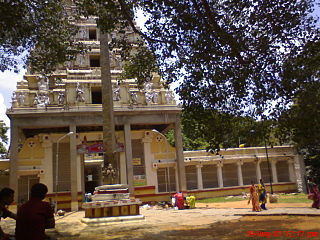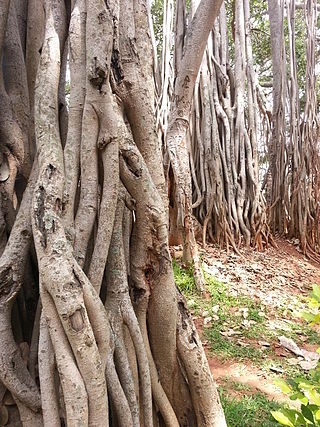
Anantapur, officially Anantapuramu, is a city in Anantapur district of the Indian state of Andhra Pradesh. It is the mandal headquarters of Anantapuru mandal and also the divisional headquarters of Anantapur revenue division. The city is located on National Highway. It was also the headquarters of the Datta Mandalam in 1799. It was also a position of strategic importance for the British Indian Army during the Second World War. The GDP of Anantapur City is $ 1.728 Billion.

Kempe Gowda I locally venerated as Nadaprabhu Kempe Gowda, or commonly known as Kempe Gowda, was a governor under the Vijayanagara Empire in early-modern India. He is famous for the development of Bangalore Town in the 16th century. Kempegowda erected many Kannada inscriptions across the region.

Dodda Basavana Gudi is situated in Bull Temple Road, Basavanagudi, area of South Bengaluru, part of the largest city of the Indian state of Karnataka. The Hindu temple is inside a park called Bugle Rock.

Cuéllar is a municipality in the Province of Segovia, within the autonomous community of Castile and León, Spain.

The Dodda Aalada Mara, literally translated to Big Banyan Tree, is a giant approximately 400-year-old banyan tree located in the village of Kethohalli in the Bangalore Urban district of Karnataka, India. This single plant covers 3 acres (1.2 ha) and is one of the largest of its kind. In the 2000s, the main root of the tree succumbed to natural disease, and thus the tree now looks like many different trees. The Dodda Alada Mara is named a heritage tree.
The Vrishabhavathi River is a minor river, a tributary of the Arkavathy, that flows through the south of the Indian city of Bangalore. The river was once so pristine that the water from it was used for drinking and used by the famous Gali Anjaneya temple but is now highly polluted due to pollutants from industrial, agricultural and domestic sources.

Basavanagudi is a residential and commercial locality in the Indian city of Bangalore. Basavanagudi is one of the oldest localities of Bangalore evidenced by the fact that it is home to four inscriptions, three Kannada and one Tamil and also one of the poshest areas of Bangalore. It is located in South Bangalore, along the borders of Jayanagar and Lalbagh Botanical Gardens. The name "Basavanagudi" refers to the Bull Temple, which contains a monolithic statue of the Nandi Bull. The word Basava in Kannada means bull, and gudi means temple. The main commercial street in Basavanagudi is DVG Road, which is home to numerous retail businesses - several of them dating back to the 1920s and 1930s. Towards the middle of DVG Road is Gandhi Bazaar, known for its market which sells fresh flowers, fruits, and vegetables. The neighbourhood includes several historic restaurants, notably Vidyarthi Bhavan, a vegetarian restaurant which opened in 1943.
Birur is a town & a hobli, located in Kadur Taluk in Chikkamagaluru district in the state of Karnataka, India. It belongs to Mysuru Division. It is located 46 km north-east from district headquarters Chikkamagaluru. The National Highway, NH-69, and State Highway 76 (Karnataka) passes through the town.

Malavalli is a town and a taluka in Mandya district in the Indian state of Karnataka. Malavalli town in history is quoted dates back to 27 March 1799 - Fourth Anglo Mysore War. Battle of Malavalli was fought between Tippu Sultan's Mysore Army against the British East India Company led by Arthur Wellesley. The men from the town fought fiercely and laid down their lives.
Sadalga is a municipal town in Chikodi Taluka in the Belagavi district of Karnataka, India. It is best known as the birth place of Digambar Jain Acharya Shri Vidyasagar Ji Maharaj. His home is recently converted into a museum.

Kurugodu is a town in the southern state of Karnataka, India. It is headquarters of Kurugodu taluk in Bellary district of Karnataka. The Sri Dodda Basaveshwara Temple is located here. Every year Ratha Mahothsava of the Swamy Dodda Basaveshwara held on holy Poornima.
Siddammanahalli is a village in the southern state of Karnataka, India. It is located in the Ballari taluk of the Ballari district.

Bugle Rock is a massive rock in the Basavanagudi area of South Bangalore, in the state of Karnataka. It is an abrupt rise above the ground of peninsular gneiss as the main rock formation and with an assessed age of about 3,000 million years. Bugle Rock has generated wide interest among the scientific community.

Shri Dharmaraya Swamy Temple is one of the oldest and most famous Hindu temples of the city of Bangalore, in Karnataka, India.

The Nanjundeshwara Temple is an ancient temple dedicated to Shiva in the Hindu pilgrimage town of Nanjanagudu in Karnataka, India. It is located on the right bank of the Kabini River, a tributary of the Kaveri River. Nanjanagudu is also known as "Dakshina Kashi" or "Kashi of South".
Veppanapalli is a town in the Krishnagiri district of Tamil Nadu, India.

The Kingdom of Coorg was an independent kingdom that existed in India from the 16th century until 1834. It was ruled by a branch of the Ikkeri Nayaka. From 1780 to 1788, the kingdom was occupied by neighbouring Mysore but the Rajah of Coorg was restored by the British and became a protectorate of the British East India Company on 26 October 1790. In 1834, the then Raja of Coorg rebelled against British authority, sparking the Coorg War. The brief conflict led to the British to annex the kingdom in the same year, who transformed the region into a province of British India.
Wandal is a village in the southern state of Karnataka, India.
Kurugodu Thammanahalli is a village in the southern state of Karnataka, India. It is located in the Gauribidanur taluk of Chikkaballapura district in Karnataka. It is situated 9 km away from sub-district headquarter Gauribidanur and 44 km away from district headquarter Chikkaballapura











